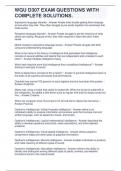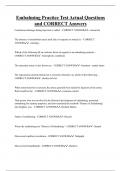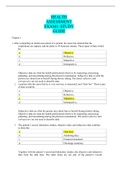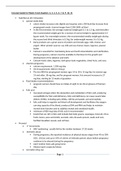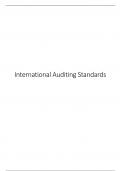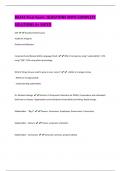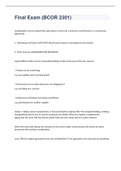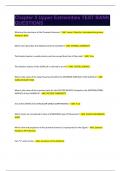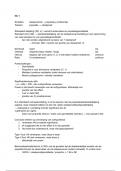Lecture 1: Introduction to Neuroscience 25-11-2022
Lecture is is not info that is going to be examined, but is expected prior knowledge.
Neuroscience is no ‘hard science’. It is a young science, growing rapidly.
Organisation of the brain
• Selection: all information will be processed (at a low level), but also selected for attention,
further processing and storage (predictive brain)
o Attention filter:
▪ Protect us from information overload
▪ Attention has a restricted capacity
▪ Unexpectant stimuli active attention
• Processing and storage: relevant information will be processed simultaneously and stored in
different parts of the brain (= long-term memory system).
o relevant = something that is personally important
• Regulation: the brain regulates through, emotions and behavior (in collaboration with the
somatic nervous system), and internal body processes (in collaboration with the automatic
nervous system).
o e.g. the prefrontal cortex is responsible for the inhibition of your impulses (eat
chocolate or not)
o e.g. the brain receives and sends information to the gut (brain-gut-axis)
o e.g. the hypothalamus regulates stress in close connection with the pituitary and
the adrenal gland (HPA-axis)
• Integration: the brain integrates incoming information (sensory input) with already
stored information (memory/ experiences)
• Prediction: the model of the predictive brain = the brain uses prior knowledge (Bayesian
statistics)
o There is no need to process all information, only what is not expected (=
predictive error). This makes the brain very efficient processing device
• Lateralization = two hemispheres with partly different functions
o LH: understanding and producing language, semantic memory
o RH: processing social and emotional stimuli, visual-spatial orientation
o LH controls the right half of your body (including the limbs) and vice versa
• Co-operation and competition: some brain parts will cooperate and some parts will
compete with each other
o Competition between top-down and bottom-up processes
▪ Top-down (high > low), and bottom-up (low . high)
▪ High = cortical areas, such as the frontal cortex (conscious processes)
▪ Low = primary projection areas, the brainstem, limbic system (habits,
learned, automatized, unconscious processes
• Small worlds, and large-scale brain networks: the brain is organized, structurally as well
as functionally, into complex networks
o This is a NEW paradigm
The Nervous System
• Central Nervous System (CNS): brain and spinal cord
• Peripheral Nervous System (PNS)
1
, o Somatic Nervous system (SNS) and autonomic Nervous system
The somatic nervous system, is composed of:
• The sensory (afferent) neurons
o That carry messages from outside the body to the central nervous system
o → specialized in transmitting messages from the eyes, ears and other sensory
receptors to the brain / spinal
• The motor (efferent) neurons
o That carry messages from the central nervous system to the skeletal muscles of the
body
o → send messages from the brain and spinal cord to the muscles that control
voluntary movements
• Every deliberate action a person makes involves neurons in somatic nervous system
Automatic nervous system
• Regulates the internal environment of the body, such as respiration, circulation and digestion
• It senses the body’s internal functions, control the glands and the smooth (involuntary)
muscles of the heart, blood vessels, stomach etc.
• Also involved in aspects of motivation, emotional behaviours and stress responses
2
,Autonomic Nervous system
• Sympathetic nervous system: physical activation, organizes a flight-or-flight response
• Parasympathetic nervous system: slows down body processes and maintains a state of
relaxation
o These 2 compete with each other
Central Nervous system
• Spinal cord
o Contains motor and sensory nerves
o Organization of reflexes
o Central pattern generators (rhythmic movements, such as walking and swimming)
• The brain
o Cranial nerves → is underneath the brain
o Brainstem
o Forebrain
3
, The brain
Hindbrain
• Brain stem supports vital life functions
o Medulla: heart rate and respiration
o Pons: sleep and arousal
• Cerebellum involved in complex rapidly changing movements that require precise timing,
memory and learning
4
Lecture is is not info that is going to be examined, but is expected prior knowledge.
Neuroscience is no ‘hard science’. It is a young science, growing rapidly.
Organisation of the brain
• Selection: all information will be processed (at a low level), but also selected for attention,
further processing and storage (predictive brain)
o Attention filter:
▪ Protect us from information overload
▪ Attention has a restricted capacity
▪ Unexpectant stimuli active attention
• Processing and storage: relevant information will be processed simultaneously and stored in
different parts of the brain (= long-term memory system).
o relevant = something that is personally important
• Regulation: the brain regulates through, emotions and behavior (in collaboration with the
somatic nervous system), and internal body processes (in collaboration with the automatic
nervous system).
o e.g. the prefrontal cortex is responsible for the inhibition of your impulses (eat
chocolate or not)
o e.g. the brain receives and sends information to the gut (brain-gut-axis)
o e.g. the hypothalamus regulates stress in close connection with the pituitary and
the adrenal gland (HPA-axis)
• Integration: the brain integrates incoming information (sensory input) with already
stored information (memory/ experiences)
• Prediction: the model of the predictive brain = the brain uses prior knowledge (Bayesian
statistics)
o There is no need to process all information, only what is not expected (=
predictive error). This makes the brain very efficient processing device
• Lateralization = two hemispheres with partly different functions
o LH: understanding and producing language, semantic memory
o RH: processing social and emotional stimuli, visual-spatial orientation
o LH controls the right half of your body (including the limbs) and vice versa
• Co-operation and competition: some brain parts will cooperate and some parts will
compete with each other
o Competition between top-down and bottom-up processes
▪ Top-down (high > low), and bottom-up (low . high)
▪ High = cortical areas, such as the frontal cortex (conscious processes)
▪ Low = primary projection areas, the brainstem, limbic system (habits,
learned, automatized, unconscious processes
• Small worlds, and large-scale brain networks: the brain is organized, structurally as well
as functionally, into complex networks
o This is a NEW paradigm
The Nervous System
• Central Nervous System (CNS): brain and spinal cord
• Peripheral Nervous System (PNS)
1
, o Somatic Nervous system (SNS) and autonomic Nervous system
The somatic nervous system, is composed of:
• The sensory (afferent) neurons
o That carry messages from outside the body to the central nervous system
o → specialized in transmitting messages from the eyes, ears and other sensory
receptors to the brain / spinal
• The motor (efferent) neurons
o That carry messages from the central nervous system to the skeletal muscles of the
body
o → send messages from the brain and spinal cord to the muscles that control
voluntary movements
• Every deliberate action a person makes involves neurons in somatic nervous system
Automatic nervous system
• Regulates the internal environment of the body, such as respiration, circulation and digestion
• It senses the body’s internal functions, control the glands and the smooth (involuntary)
muscles of the heart, blood vessels, stomach etc.
• Also involved in aspects of motivation, emotional behaviours and stress responses
2
,Autonomic Nervous system
• Sympathetic nervous system: physical activation, organizes a flight-or-flight response
• Parasympathetic nervous system: slows down body processes and maintains a state of
relaxation
o These 2 compete with each other
Central Nervous system
• Spinal cord
o Contains motor and sensory nerves
o Organization of reflexes
o Central pattern generators (rhythmic movements, such as walking and swimming)
• The brain
o Cranial nerves → is underneath the brain
o Brainstem
o Forebrain
3
, The brain
Hindbrain
• Brain stem supports vital life functions
o Medulla: heart rate and respiration
o Pons: sleep and arousal
• Cerebellum involved in complex rapidly changing movements that require precise timing,
memory and learning
4


